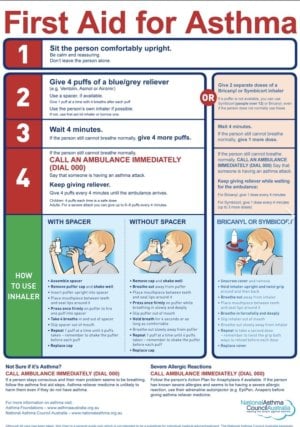Conditions change and health risks increase, prompting widespread precautions
By
- Replies 16
Thunderstorm asthma is a unique and potentially life-threatening phenomenon that can catch many by surprise, particularly during the spring and summer months when the risk is at its highest.
Recently, Aussies have been put on high alert for such an event, with the Department of Health issuing a warning for a 'high risk' of epidemic thunderstorm asthma that could affect parts of the state.
For those unfamiliar with the term, thunderstorm asthma occurs when a storm front sweeps high grass pollen levels and dust into the air.
The storm's winds break these particles into smaller particles.
When inhaled, these smaller particles can penetrate deep into the lungs, triggering severe asthma attacks in susceptible individuals.
Victoria's chief health officer, Dr Clare Looker, has emphasised the seriousness of the situation.
She noted that a combination of high grass pollen levels and the right kind of thunderstorm with strong winds could suddenly increase asthma symptoms.
This is particularly concerning for individuals with existing respiratory conditions, such as asthma or hay fever, as well as those with undiagnosed asthma.
The warning comes with a sad reminder of the 2016 thunderstorm asthma event in Melbourne, which was the deadliest in the world.
During that event, ten people lost their lives, and approximately 3,500 sought medical attention within 30 hours, overwhelming the healthcare system.
Dr Looker advised residents in the North Central, West, and South Gippsland districts to take precautions to mitigate the risks.
'Close your windows and doors and turn off air conditioners that bring in air from the outside (such as evaporative air conditioners),' she said.
'People with asthma should have their reliever medication with them at all times today and review their asthma action plan.'
For those with asthma, it's crucial to always have reliever medication on hand and to review their asthma action plans.
Similarly, individuals with spring hay fever should familiarise themselves with asthma first aid and ensure quick access to asthma reliever medication.
If someone begins to feel unwell, Dr Looker urges them to seek immediate assistance.


Have you or someone you know been affected by thunderstorm asthma? What precautions do you take to stay safe during these high-risk periods? Let us know in the comments below.
Recently, Aussies have been put on high alert for such an event, with the Department of Health issuing a warning for a 'high risk' of epidemic thunderstorm asthma that could affect parts of the state.
For those unfamiliar with the term, thunderstorm asthma occurs when a storm front sweeps high grass pollen levels and dust into the air.
The storm's winds break these particles into smaller particles.
When inhaled, these smaller particles can penetrate deep into the lungs, triggering severe asthma attacks in susceptible individuals.
Victoria's chief health officer, Dr Clare Looker, has emphasised the seriousness of the situation.
She noted that a combination of high grass pollen levels and the right kind of thunderstorm with strong winds could suddenly increase asthma symptoms.
This is particularly concerning for individuals with existing respiratory conditions, such as asthma or hay fever, as well as those with undiagnosed asthma.
The warning comes with a sad reminder of the 2016 thunderstorm asthma event in Melbourne, which was the deadliest in the world.
During that event, ten people lost their lives, and approximately 3,500 sought medical attention within 30 hours, overwhelming the healthcare system.
Dr Looker advised residents in the North Central, West, and South Gippsland districts to take precautions to mitigate the risks.
'Close your windows and doors and turn off air conditioners that bring in air from the outside (such as evaporative air conditioners),' she said.
'People with asthma should have their reliever medication with them at all times today and review their asthma action plan.'
For those with asthma, it's crucial to always have reliever medication on hand and to review their asthma action plans.
Similarly, individuals with spring hay fever should familiarise themselves with asthma first aid and ensure quick access to asthma reliever medication.
If someone begins to feel unwell, Dr Looker urges them to seek immediate assistance.
Tip
This could be by contacting the Nurse on Call at 1300 60 60 24, visiting the Victorian Virtual Emergency Department at www.vved.org.au, or consulting their doctor.
Key Takeaways
- Victorians have been warned of a 'high risk' for an epidemic thunderstorm asthma event in some regions of the state.
- High grass pollen levels combined with a specific thunderstorm could lead to a swift onset of asthma symptoms.
- Residents in North Central, West and South Gippsland districts are advised to stay indoors and prepare for the impending conditions.
- People with asthma, hay fever, or undiagnosed asthma are at increased risk, and health and emergency services are alert to respond.









